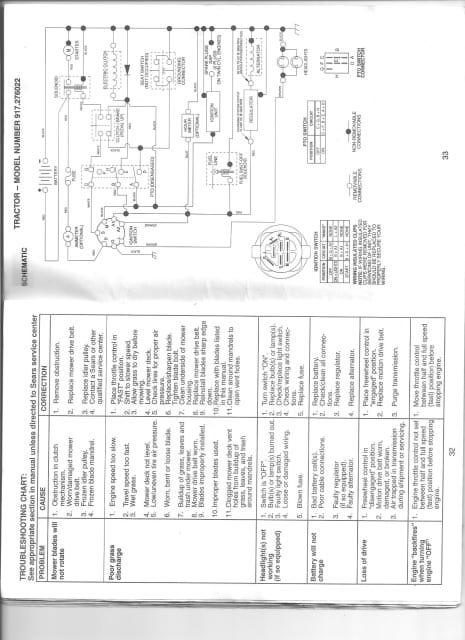QuestionQUESTION: I have had a tough time getting my lawnmower going this spring. First time starting up after a long winter.
I replaced the battery because it was time. I started the unit no problem, then went I went to engage the PTO, the clutch engaged for a moment and then the mower stalled. When I tried to restart I got nothing. I discovered that it blew the 30amp fuse so I replaced it. I started the lawnmower back up - but this time when I went to pull the PTO switch, I got nothing!
The other features of the switch are working perfectly fine (such as kill when I get up off seat), only the PTO will not trigger the clutch for the blades.
I investigated further and discovered if I bypassed the switch and provided 12v direct to the pigtail connected to the PTO clutch - The blades engaged. So I borrowed another working PTO switch from my brothers mower thinking it was the PTO switch and it also did not work (I Hope I didn't kill his!).
AFTER EVEN FURTHER investigation, I discovered there is (was) a diode installed in the lead going to the pigtail on the pto clutch. It was FRIED. Now I'm thinking that the dead burnt diode is the thing that killed my PTO switch (and hopefully not my brothers).
IF I jumper the PTO leads (B +E) , the clutch engages and I'm cutting grass.
So - HELP! I'm confused as how to proceed.
1) Is the diode necessary at all? I read a post somewhere saying it's not even needed
2) Do you think I killed the substitute switch ?
I appreciate ANY helpful instruction on this - it has taken quite a bit of my time to debug and come to where I am right now.
ANSWER: Is you model number 247203740? You'll find the model number on a sticker, about the size of a business card, usually under the seat of fenders.
The diode may be installed to act like a fuse or prevent reverse current flow.
I need the mowers model number to look up the wiring diagram so I can see what you have.
Eric
---------- FOLLOW-UP ----------
QUESTION: Eric, That would make sense, because the symptoms are all pointing to a fuse type situation - especially because everything started at the same time. The 30 amp fuse blew and when I went to activate the PTO for first time - it initially, very briefly, engaged the clutch and then died. After that no power. The diode was definitely fried - when I pulled back the shrink wrap - it disintegrated into powder.
I have my manual and a copy of the schematic. I see the diode on there, just not sure if it's required or not. I don't understand how I am able to just provide 12v direct to the clutch and it works, but not through the hot lead that contained the diode.
The model number is 917.276022 on this unit.
I also read someplace it could be the clutch itself which may be blowing the diode? Don't really use the mower that much (1x/week) on 1 acre. I also did confirm that when I installed another pto switch - it did indeed kill the pto switch which engages the blade (2 down now). Not going to proceed until I have clearer direction :-)
ANSWER: Do you have an Ogura brand clutch? According to the parts I looked up you should have an Ogura. Visit the URL below and see the section on "Clutch will not engage" to check the coil resistance. It should not be zero ohms.
http://www.ogura-clutch.com/products/pto/troubleshooting/will-not-engage.html
If you have a Warner clutch Google "warner eclectric pto testing" or try to copy/paste the URL below"
http://www.kingcat.co.nz/files/Warner%20Clutch%20Adjustment.pdf
You will notice resistance readings as well...2.40-2.90 ohms.
Let me know the resistance of the clutch.
How detailed is the schematic you have? The ones I found online are not very detailed...they do not show any diodes.
Eric
---------- FOLLOW-UP ----------
 Schematic
Schematic
QUESTION: I measured the resistance - it's 3.1 ohms which is within tolerance. I am attaching the schematic that came with the manual - not sure it will help you at all because there's no ratings on the components. Clutch works perfectly when I apply 12v from jumpered switch.
I bought another switch but don't want to burn it out! For now, I have been cutting the grass by jumpering the switch (B+E) and everything works perfect. The diode was fried to a crisp so I removed it and shrink wrapped any bare exposed wires.
I measured 12.5v at the switch when the switch is turned to ON. All other switches operate fine (F+C, and D+A). What do you think would happen if I connect the new switch since I have removed the blown diode? What else could I test to ensure this won't blow another switch?
AnswerYou could blow another switch. Have you read up on diodes. The one in the schematic it a basic diode, not a zener diode according to the schematic symbol.
http://www.learnabout-electronics.org/diodes_01.php
Based on the URL above and the schematic, the diode in your circuit is for protection.
This URL maybe helpful and it makes sense:
http://forums2.gardenweb.com/forums/load/tractor/msg0519332717848.html
Also read these below. Some responses are not correct but the chatter and suppression comments are spot on based on all the electronic training I have taken...the diode is acting as a protection device.
http://forums2.gardenweb.com/forums/load/tractor/msg0519332717848.html
http://www.lawnsite.com/archive/index.php/t-294843.html
You could test the regulator to make sure it is not malfunctioning and the key switch as well.
Are you have trouble finding a replacement diode?
http://www.mouser.com/ProductDetail/Fairchild-Semiconductor/P6KE62CA/?qs=DJXoKr4
Another decent read:
http://www.lawnmowerforum.com/kohler-engine-forum/14221-kohler-will-not-start.ht
Eric
